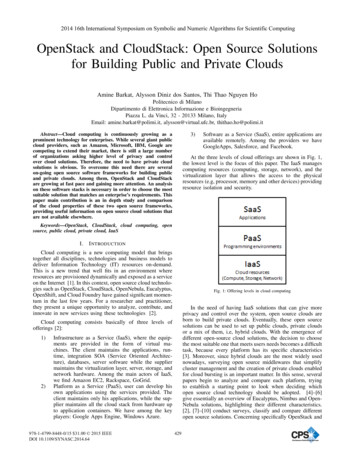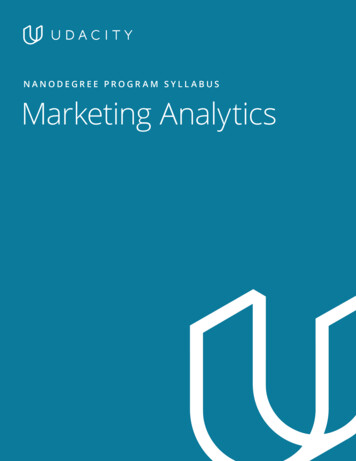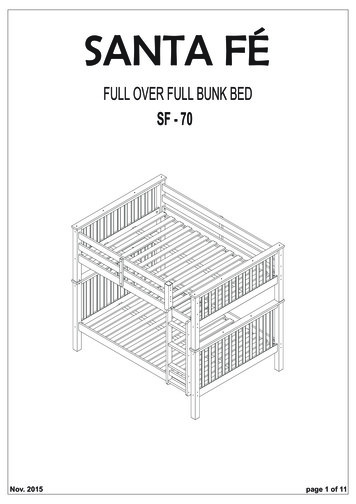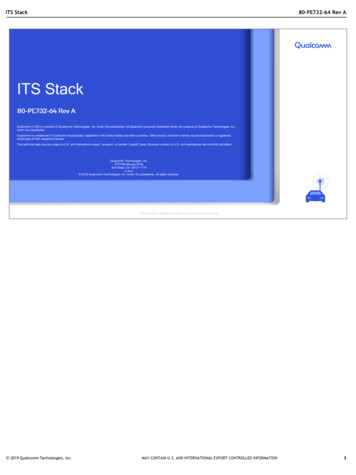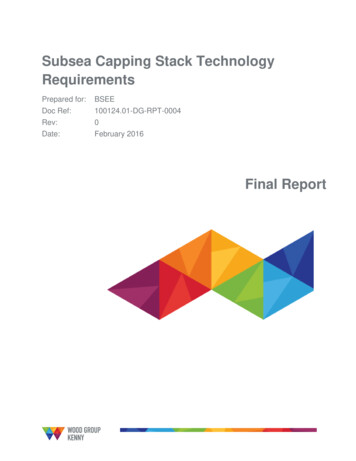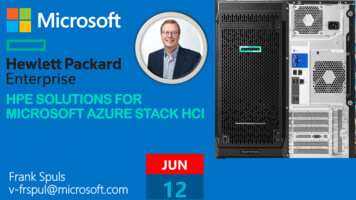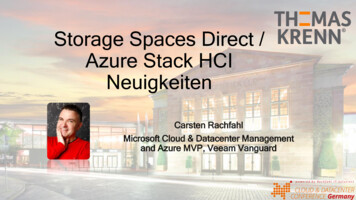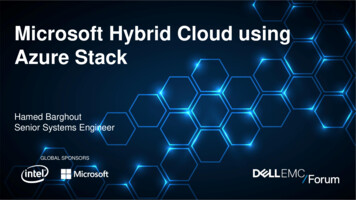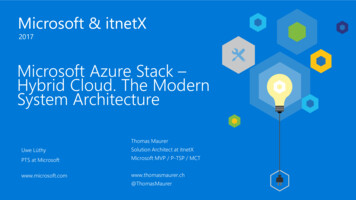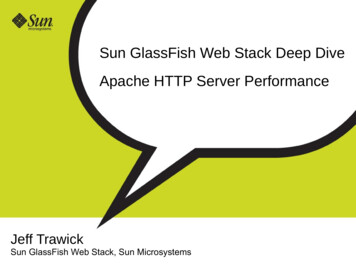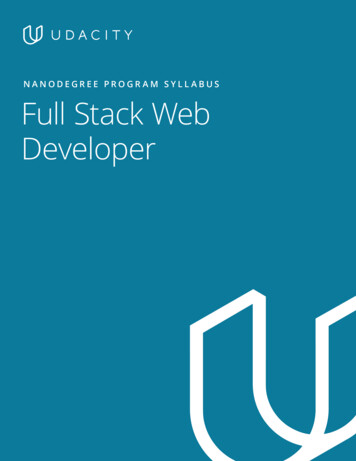
Transcription
NANODEGREE PROGR AM SYLL ABUSFull Stack WebDeveloperNeed Help? Speak with an Advisor: www.udacity.com/advisor
OverviewThe goal of the Full Stack Web Developer Nanodegree program is to equip learners with the unique skillsthey need to build database-backed APIs and web applications. A graduate of this program will be able to: Design and build a database for a software application Create and deploy a database-backed web API (Application Programming Interface) Secure and manage user authentication and access control for an application backend Deploy a Flask-based web application to the cloud using Docker and KubernetesThis program includes 4 courses and 5 projects. Each project you build will be an opportunity toapply what you’ve learned in the lessons and demonstrate to potential employers that you have practicalfull-stack development skills.Estimated Time:4 Months at5-10hrs/weekPrerequisites:Prior experiencewith Python, CSS/HTML, and GitFlexible Learning:Self-paced, soyou can learn onthe schedule thatworks best for youNeed Help?udacity.com/advisorDiscuss this programwith an enrollmentadvisor.Need Help? Speak with an Advisor: www.udacity.com/advisorFull Stack Web Developer 2
Course 1: SQL and Data Modeling for the WebMaster relational databases with the power of SQL, and leverage Python to incorporate database logic into yourprograms.For your first project, you’ll be building out the data models anddatabase for an artist/venue booking application. The fictitiousstartup Fy-yur is building a website that facilitates bookings betweenartists who can play at venues, and venues who want to book artists.Course ProjectDesign a Venue BookingDatabaseThis site: Lets venue managers and artists sign up, fill out theirinformation, and list their availability for shows. Lets artists browse venues where they can play, and see whatpast/upcoming artists have been booked at a venue. Lets a venue manager browse artists that would like to play intheir city, and see what past/upcoming venues where the artisthas played/will be playing.The goal of this project is to build out the data models for thisbooking application. A prototype design of the web app will beprovided. You’ll use SQLAlchemy and Postgresql to build out thedata models upon which this site will rely. You’ll write out both theraw SQL and SQLAlchemy commands to run for poweringthe backend functionality of the website.LEARNING OUTCOMESLESSON ONEConnecting andInteractingwith DatabasesNeed Help? Speak with an Advisor: www.udacity.com/advisor Describe and explain the client-server model Describe and explain the TCP/IP communication protocol Describe and explain the base unit of database work:transactions Install the PostgreSQL database management system Create and manage Postgres databases with the psql client Install the psycopg2 Python Postgres database driver Create and manage Postgres databases using the psycopg2Python database driverFull Stack Web Developer 3
Intro to SQLAlchemyandSQLAlchemy ORMBasics Describe and explain the use cases for an Object RelationalMapping (ORM) library Describe and explain the abstraction layers of SQLAlchemy Connect to and manage a database using composable SQLexpressions Define data model objects with Python using SQLAlchemyORM Connect data models to a lightweight Flask web application Build data models using different types of dataSQLAlchemy ORM inDepth Explore and retrieve data using the SQLAlchemy Model.query object Create database sessions for executing databasetransactions Execute database transactions within a connection session Describe and explain the SQLAlchemy object lifecycle Build a lightweight data app using SQLAlchemy Describe and explain the Model-View-Controller (MVC)application architecture Retrieve from data from a webform using Flask Update data models using data migrations Migrate data using Flask-Migrate and Flask-Script Define and code relationships between tables and objectsusing SQLAlchemy Implement database methods to query relationshipsbetween data modelsLESSON FOURBuild a CRUD AppwithSQLAlchemy ORM Part 1 Use the CRUD (Create, Read, Update, Delete) model to builda small database backed app Capture user input from a webform to add and modify datato a database Manage data using database sessions in an applicationcontrollerLESSON FIVEMigrations Modify a data schema using Flask-Migrate and Alembic Write migration scripts to update data schemas using FlaskScriptBuild a CRUD AppwithSQLAlchemy ORM Part 2 Update database models using webforms and applicationrouting Delete information from a database using SQLAlchemy Model and control relationships between different types ofdata objects Implement one-to-many and many-to-many relationshipsusing SQLAlchemy Execute complex database queries on related data modelsLESSON TWOLESSON THREELESSON SIXNeed Help? Speak with an Advisor: www.udacity.com/advisorFull Stack Web Developer 4
Course 2: API Development and DocumentationLearn how to use APIs to control and manage web applications, including best practices for API testing anddocumentation.In this project, you will use the skills you’ve developed to build aTrivia API. The API will allow users to: Search for trivia questions and answers via category anddifficulty Add new questions Modify the difficulty rating of questions.The goal of this project is to use APIs to control and manage a webapplication using existing data models. You’ll be given a set of datamodels and the application front end. Your task will be to implementthe API in Flask to make the Trivia game functional.Course Project:Trivia APILEARNING OUTCOMESLESSON ONELESSON TWOIntroduction toAPIs Describe and explain the definition and use cases of APIs(Application Programming Interface) Describe and explain how APIs are used to connect applicationfront ends to server backendsHTTP and FlaskBasics Describe and explain the Hypertext Transfer Protocol (HTTP) Describe and explain the components of an HTTP request Describe and explain the different HTTP methods (verbs) Describe and explain HTTP status codes Request information from a server using cURL and HTTPrequests Install the Python Flask micro application framework Set up and Configure a Flask application Create a Flask endpoint (route)Need Help? Speak with an Advisor: www.udacity.com/advisorFull Stack Web Developer 5
Endpoints andPayloads Structure and Organize API Endpoints Describe and explain Cross-Origin Resource Sharing (CORS) Manage CORS requests using HTTP headers Manage CORS controls using Flask-CORS Parse request path and body from an HTTP request Implement HTTP POST, PATCH and DELETE methods usingFlask Handle application errors using FlaskLESSON FOURAPI Testing Describe and explain the purpose and benefits of API testing Test a REST API using Flask and unittest Develop an application iteratively and safely using Test DrivenDevelopment (TDD)LESSON FIVEAPI Documentation Read and explore API documentation from a number of APIdevelopers Write effective documentation for your own APILESSON THREENeed Help? Speak with an Advisor: www.udacity.com/advisorFull Stack Web Developer 6
Course 3: Identity Access ManagementImplement authentication and authorization in Flask and understand how to design against key securityprinciple. You will also gain experience with role-based control design patterns, securing a REST API, andapplying software system risk and compliance principles.In the third project of the program, you will build the backend for acoffee shop application. You’ll add user accounts and authenticationto your application and use role-based access managementstrategies to control different types of user behavior in the app. Theapplication must: Display graphics representing the ratio of ingredients in eachdrink. Allow public users to view drink names and graphics. Allow the shop baristas to see the recipe information. Allow the shop managers to create new drinks and edit existingdrinks.Course ProjectIdentity AccessManagementThis project will give you a hands-on chance to practice anddemonstrate your new skills, such as: Implementing authentication and authorization in Flask Designing against key security principles Implementing role-based control design patterns Securing a REST API Applying software system risk and compliance principlesLEARNING OUTCOMESLESSON ONELESSON TWOFoundations Describe and explain the use cases and differences betweenauthorization and authentication Describe the problem of security and the risks of unsecuredor improperly secured application systems Describe different types of security attack Inspect requests and responses for an application usingPostmanAuthentication Describe common methods for application authentication Explain why passwords are not the ideal method forauthentication Implement an application authentication layer with Auth0 Secure API communications using JSON Web Tokens (JWT)Need Help? Speak with an Advisor: www.udacity.com/advisorFull Stack Web Developer 7
LEARNING OUTCOMESLESSON ONELESSON TWOLESSON THREEPasswords Describe the risks associated with password controlledsystems Mitigate access risks associated with SQL injection byvalidating and sanitizing database inputs Secure database data in a database using standard encryptionpractices Describe how an attacker can use rainbow tables to gainaccess to a system Improve security of hashed passwords and encrypted datausing the ‘salt’ method Increase application security by using best practices to avoidlogging and serializing sensitive dataAuthorization Describe the concept of authorization and access control Define ‘permissions’ in the context of an application Constrain permissions in an application by using role-basedaccess control (RBAC) Define permission roles using Auth0 Identify user permissions and roles from JWTs (JavaScript WebTokens)ThinkingAdversarially Prevent accidental access to privileged information in Gitrepositories by using environment variables Mitigate risks to Git master branch changes by developing infeature branches Employ code review as a practice to mitigate security risks Test API and authentication practices with integration testing Describe common types of adversarial attacks on networksystems.Need Help? Speak with an Advisor: www.udacity.com/advisorFull Stack Web Developer 8
Course 4: Server Deployment andContainerizationDevelop an understanding of containerized environments, use Docker to share and store containers, anddeploy a Docker container to a Kubernetes cluster using AWSCourse ProjectDeploy a Flask App toKubernetes Using EKSIn this project, you will create a container for your Flask web appusing Docker and deploy the container to a Kubernetes clusterusing Amazon EKS. By the end of the project, you will have deployedyour application live to the world, where it should be accessible byIP address. You’ll use automated testing to prevent bad code frombeing deployed and monitor your app’s performance using AWStools.Course ProjectFull Stack Web DeveloperNanodegree ProgramCapstoneIn this final capstone project, you will combine all of the newskills you’ve learned and developed in this course to construct adatabase-backed web API with user access control. You will choosewhat app to build and then you’ll design and build out all of the APIendpoints needed for the application and properly securethem for use in any front end application (web or mobile).LEARNING OUTCOMESLESSON ONEContainersNeed Help? Speak with an Advisor: www.udacity.com/advisor Describe and explain the benefits and use cases forcontainerized environments Install Docker on a local machine Define a container environment using a Dockerfile Download and launch a Docker container Store and share a docker containerFull Stack Web Developer 9
LESSON TWODeploymentNeed Help? Speak with an Advisor: www.udacity.com/advisor Describe and explain container orchestration, how it worksand the general use case Describe and explain how Kubernetes manages containerclusters Deploy a Docker container to a Kubernetes cluster usingAWS EKS and the AWS command line interface (CLI) Manage Kubernetes clusters using the AWS CLI Implement Continuous Delivery (CD) and ContinuousIntegration (CI) with AWS CodePipeline and AWS CodeBuildFull Stack Web Developer 10
Our Classroom ExperienceREAL-WORLD PROJECTSBuild your skills through industry-relevant projects. Getpersonalized feedback from our network of 900 projectreviewers. Our simple interface makes it easy to submityour projects as often as you need and receive unlimitedfeedback on your work.KNOWLEDGEFind answers to your questions with Knowledge, ourproprietary wiki. Search questions asked by other students,connect with technical mentors, and discover in real-timehow to solve the challenges that you encounter.WORKSPACESSee your code in action. Check the output and quality ofyour code by running them on workspaces that are a partof our classroom.QUIZZESCheck your understanding of concepts learned in theprogram by answering simple and auto-graded quizzes.Easily go back to the lessons to brush up on conceptsanytime you get an answer wrong.CUSTOM STUDY PLANSCreate a custom study plan to suit your personal needsand use this plan to keep track of your progress towardyour goal.PROGRESS TRACKERStay on track to complete your Nanodegree program withuseful milestone reminders.Need Help? Speak with an Advisor: www.udacity.com/advisorFull Stack Web Developer 11
Learn with the BestAmy HuaCaryn McCarthyI N S T R U C TO RI N S T R U C TO RAmy has 6 years of experience as asoftware professional, building everythingfrom data visualizations to self-drivingcars. She’s been a bootcamp instructor,StartupBus mentor, and Girls Who Codeinstructor.Caryn has worked as a software developerand as Coach and Experience Manager atCode Next at Google. She is passionateabout diversity and equity in tech, isalways working to create positive impactin the tech industry and the world.Gabriel RuttnerKennedy BehrmanI N S T R U C TO RI N S T R U C TO RGabe is the CTO at Ursa & Tech Advisorfor Start-Ups. He has expertise in buildingcloud-based machine learning and naturallanguage processing services at earlystage tech companies. He holds technicaldegrees from Cornell University and StonyBrook University.Kennedy is a veteran consultant andauthor, specializing in architecting andimplementing cloud solutions for earlystage startups. He is experienced in dataengineering, data science, AWS solutions,and engineering management.Need Help? Speak with an Advisor: www.udacity.com/advisorFull Stack Web Developer 12
All Our Nanodegree Programs Include:EXPERIENCED PROJECT REVIEWERSREVIEWER SERVICES Personalized feedback & line by line code reviews 1600 Reviewers with a 4.85/5 average rating 3 hour average project review turnaround time Unlimited submissions and feedback loops Practical tips and industry best practices Additional suggested resources to improveTECHNICAL MENTOR SUPPORTMENTORSHIP SERVICES Questions answered quickly by our team oftechnical mentors 1000 Mentors with a 4.7/5 average rating Support for all your technical questionsPERSONAL CAREER SERVICESC AREER SUPPORT Resume support Github portfolio review LinkedIn profile optimizationNeed Help? Speak with an Advisor: www.udacity.com/advisorFull Stack Web Developer 13
Frequently Asked QuestionsPROGR AM OVERVIE WWHY SHOULD I ENROLL?Becoming a software engineer is one of the best career moves you canmake. Udacity built this Nanodegree program with input from leaders inthe software industry to provide world-class Full Stack Web Developmentinstruction that features code reviews and mentorship support throughoutthe program.In the Full Stack Web Developer Nanodegree program, you will: Design and implement relational database systems to store and manageapplication data. Build dynamic software application backend systems using the Pythonprogramming language and the popular Flask application framework. Configure and deploy your applications to the cloud (Amazon WebServices)WHAT JOBS WILL THIS PROGRAM PREPARE ME FOR?Completion of the Full Stack Web Developer Nanodegree program will giveyou the tools needed to perform well in a variety of developer roles.Some examples of job titles that align with your new skills are:Software Engineer, Full Stack Python Application Developer, Back EndDeveloper, Web Application DeveloperHOW DO I KNOW IF THIS PROGRAM IS RIGHT FOR ME?As a Full Stack Web Developer, you are the go-to person that companies relyon to build, support and maintain their web applications. Regardless of theplatform, full stack web developers are in demand by nearly every company.Ifyou are interested in building out the infrastructure that powers and supportsthe many web, desktop, mobile and integrated applications in the world, thisprogram is the best way to get started.WHAT IS THE DIFFERENCE BETWEEN THE FRONT END WEB DEVELOPERPROGRAM AND FULL STACK WEB DEVELOPER PROGRAM?Web development generally fits into distinct concentrations, such as front endweb development and full stack web development.As a front end web developer, you’ll build responsive, dynamic user interfaceson the web. You’ll leverage your HTML, CSS, and JavaScript skills to manage allclient-side scripting.As a full stack web developer, you’ll have an active hand in implementingrelationship databases, configure and deploy your applications to the cloud,and build dynamic software application backend systems using the PythonNeed Help? Speak with an Advisor: www.udacity.com/advisorFull Stack Web Developer 14
FAQs Continuedprogramming language.Whichever path you choose, you’ll be building involved, engaging experienceson the web for your users!ENROLLMENT AND ADMISSIONDO I NEED TO APPLY? WHAT ARE THE ADMISSION CRITERIA?No. This Nanodegree program accepts all applicants regardless of experienceand specific background.WHAT ARE THE PREREQUISITES FOR ENROLLMENT?Minimum Requirements: Beginner-level experience in Python. If you do not have this experience,check out our Intro to Programming Nanodegree program or Intro toComputer Science course. Experience building front-end web sites with HTML, CSS, and Javascript. Experience using Git for version control. If you do not have thisexperience, check out our How to Use Git and GitHub course. You are self-driven and motivated to learn. Participation in this programrequires consistently meeting the deadlines, and devoting at least 10hours per week to your work. You can communicate fluently and professionally in written and spokenEnglish. You have access to a computer with a broadband connection, on whichyou’ll install a professional code/text editor (ie. VSCode or Atom) as wellas virtual machines (using VirtualBox and Vagrant). You are willing to contribute to the success of the program, includingcollaborating with fellow students, and giving us feedback on how we canimprove.Desirable Prior Experience:: You’ve completed an object-oriented Python programming course. You’ve tried to build server-side applications in the past and want tolearn how to do it at a professional level.IF I DO NOT MEET THE REQUIREMENTS TO ENROLL, WHAT SHOULD I DO?We have a number of Nanodegree programs and free courses that can helpyou prepare, including: Intro to Programming Nanodegree Program Data Structures and Algorithms Nanodegree Program Front End Web Developer Nanodegree ProgramNeed Help? Speak with an Advisor: www.udacity.com/advisorFull Stack Web Developer 15
FAQs ContinuedTUITION AND TERM OF PROGR AMHOW IS THIS NANODEGREE PROGRAM STRUCTURED?The Full Stack Web Developer Nanodegree program includes content andcurriculum to support 5 (five) projects. We estimate that most students cancomplete the program in four (4) months working 5-10 hours per week.Each project will be reviewed by the Udacity reviewer network. Feedback willbe provided and if you do not pass the project, you will be asked to resubmitthe project until it passes.HOW LONG IS THIS NANODEGREE PROGRAM?Access to this Nanodegree program runs for the length of time specified inthe payment card above. If you do not graduate within that time period, youwill continue learning with month to month payments. See the Terms of Useand FAQs for other policies regarding the terms of access to our Nanodegreeprograms.SOF T WARE AND HARDWAREWHAT SOFTWARE AND VERSIONS WILL I NEED IN THIS PROGRAM?For this program, you will need a computer with a broadband internetconnection, capable of hardware. Note: Most consumer computers on themarket today meet these requirements. You will need administrative accessto be able to install software on your computer. This program uses Python 3.7,PostgreSQL 11, SQLAlchemy, Flask 1.0, Docker and various Python packages.Students will need to be able to communicate fluently and professionally inwritten and spoken English.Need Help? Speak with an Advisor: www.udacity.com/advisorFull Stack Web Developer 16
The goal of this project is to build out the data models for this booking application. A prototype design of the web app will be provided. You’ll use SQLAlchemy and Postgresql to build out the data models upon which this site will rely. You’ll write out bot
